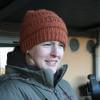Hi WILDLABS Community,
My colleagues and I are currently using Insta360 cameras to gather underwater video footage of beluga whales in the Churchill River estuary (Canada). While this has given us amazing footage of these whales, we are struggling to use the 360 environment to extract relevant scientific information beyond simple behavioural observations, or without having to painstakingly edit and flatten each video using the proprietary software included with the cameras.
Our original workflow utilizes a single direction camera providing us with 'flat' videos of beluga whales when in view. We split these videos into individual frames. Empty frames are dropped by a custom machine learning algorithm to retain only frames with beluga in them (read more here). These frames are then fed into our Zooniverse project, Beluga Bits, for further classification through a variety of workflows to extract information (ages, sexes, markings, etc.) and make observations on other species present, like jellyfish.
Essentially, the advantage of these 360 cameras is that we can track individuals for more than just a narrow window into the sea. However, we are struggling to find a solution that might allow us to track individuals as they move through the 360-degree videos, and then extract frames or a series of frames of that individual in an encounter.
I'm somewhat aware of computer vision efforts, and a few others, but we find ourselves at a loss to overcome this challenge. I just thought I'd find out if anyone knows of a solution or can point us in the right direction.
Thanks! Any help would be greatly appreciated!
Courtney
28 July 2025 4:02pm
This is really cool work. I’ve seen a few papers use 360 video + object tracking (like from VR or autonomous driving research) — wondering if tools like Detectron2 or SAM could be adapted here. Would love to follow how you solve this.

Alex Rood
WILDLABS
World Wide Fund for Nature/ World Wildlife Fund (WWF)
5 August 2025 5:20pm
Hey Courtney! I've just sent you an email about coming on Variety Hour to talk about your work :) Looking forward to hearing from you!
9 August 2025 12:44am
Hi @CourtneyShuert
We support NOAA with AI for individual ID for belugas (but from aerial and from lateral surface too). If some of our techniques can be cross-applied please reach out: jason at wildme dot org
Cheers,
Jason
















Ariho Jonathan